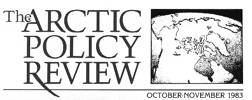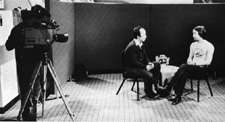
Northern Broadcasting Comes of Age:
ICC Media Coverage

IBC reporter Peter Tapati interviews Mark Gordon for broadcast throughout northern Canada in Inuktitut.
Not one, but several northern news agencies extended themselves to cover the ICC meeting in Frobisher Bay, making it the best-covered event ever to take place in the Arctic. Special mention goes to the Inuit Broadcasting Corporation, Alaska’s Tundra Times , and the Alaska Public Radio Network (APRN). The event marked a breakthrough in northern journalism.
Five radio journalists form Alaska came and with help from CBC Northern Service were able to file a one-hour report daily in English, which was broadcast throughout Alaska, the Yukon and Northwest Territories, and Northern Quebec. Karen McPherson of KUAC in Fairbanks, produced seven half-hour “Chinook” programs that aired later on the Alaska network.
Peter Frederik Rosing headed up a five-man team filing stories for Greenland Radio, and Lars Rasmussen represented Atuagagdluitit (the Greenland Post) and the Danish news media. Greenlandic filmmaker Miki Seigstad was there, producing a film on the event together with a crew of Canada’s National Film Board.
The Inuit Broadcasting Corporation was the host and TV broadcaster for the event, managing to air sixteen hours of TV productions, while at the same time providing the link-up and feeds for other production teams. The IBC coverage was the largest-scale broadcast ever to take place in the North.
The southern Canadian press was represented by only one journalist, Ed Struzik of the Edmonton Journal. A crew from CBS-TV came to Frobisher Bay for one day — to get a story on the Telidon demonstration. Freelance writer Francois Bellemare filed ICC stories with Le Devoir of Montreal, reaching the world’s French-speaking populations. Other southern Canadian newspapers were content to run Associated Press stories written by its Montreal correspondent, Charles Campbell, whose well-written reports were printed in newspapers across Canada and the U.S., making them the most widely-read of all.
The stories filed by Stanley Meisler for the Los Angeles Times and Michael Kaufman for the New York Times were also widely read and reprinted throughout the U.S. Special mention goes to Ellen Hamilton and the rest of the staff of Frobisher Bay’s Nanatsiaq News whose three bilingual ICC issues of the paper are an excellent printed on-the-spot record of the event. The FairbanksDaily News-Miner sent Stan Jones to cover the event, and his stories were also featured in the Anchorage Daily News.
Bill Hess’s in-depth articles, appearing in several issues of the Tundra Times, provided Alaskan readers with the most complete written accounts of the week’s events and personalities. His ICC coverage is tribute to an expanded editorial policy of the Tundra Times to embrace circumpolar issues. TT’s coverage will serve Alaskans well in preparing for the Fourth ICC meeting to take place in Kotzebue in 1986.
The IBC: a stellar performance
The performance of the Inuit Broadcasting Corporation at the ICC meeting established its arrival as the premier TV broadcaster of the North. Its coverage, entirely in Inuktitut, marked the first occasion that the ICC proceedings were telecast on a same-day basis across Canada. The IBC, supported by CBC Northern Services, also provided technical assistance and support to TV production crews from Greenland and Alaska. The Alaska TV effort was led by the North Slope Borough production team headed by Tom Shackle, who filed the daily reports of Anchorage journalists Carolyn Morandi (KIMO) and Malin Jennings (KTUU) with Alaska and U.S. networks via the Canadian ANIK-B satellite.
The IBC gained new expertise in coordinating the work of its own production crews in Frobisher Bay and those brought in from Baker Lake, Igoolik, and Eskimo Point, as well as the crew of Taqramiut Nipingat, IBC’s counterpart in Northern Quebec, which provided coverage of the week’s entertainment. CBC Northern Service also funded and broadcasted a live music concert.
CBC Northern Service was also the host broadcaster for radio, providing audio production facilities for guest broadcasters, and producing live and taped programming in both English and Inuktitut for broadcast throughout Canada and Alaska.
The success of IBC’s TV broadcasting and its high standard of performance changed a lot of people’s assumptions about broadcasting in Inuit languages, and about the Inuit broadcasting itself. As a result of what happened during the meeting, Inuit leaders are now looking at sponsoring broadcast links across the North and throughout the circumpolar world. Many agreed that the ICC came along at just the right time for the Inuit to take a position of leadership in northern broadcasting.
The performance of the IBC in supplying high-quality same-day reportage in Inuktituk to villages across the Canadian north — an unthinkable accomplishment only ten years ago — is tribute to the work of IBC president Joseph Padlyat, IBC executive director of the ICC coverage Elisapee Davidee, and Keith MacNeil, IBC’s studio manager in Frobisher Bay.
The Telidon Project
Many conference participants were disappointed in the performance of the ICC-Telidon demonstration. Though grandly advertised by government and industry as the new wave of communications in the North, many of its promising features failed to materialize. The Telidon monitors sent to Alaska failed to work, and those in Frobisher Bay frequently broke down. There were complaints heard about the slow response time — the time it takes for the system to assembly a screen of information, difficulties in entering and editing information, and the failure to provide conference users with access to the Novatex data bank.
But the Telidon project had significant side effects, not the least of which was the $215,000 granted by the Canadian government to aid the Canadian Inuit in hosting the conference. According to ICC executive committee member John Amagoalik, the government had stakes in the meeting because of the Department of Communications Telidon demonstration slated to promote Canada’s version of videotext communications in the North.
ICC Communications and Broadcasting Commission
The Frobisher Bay meeting was also marked by the publication of two important media-related documents, the Report of the ICC Communications and Broadcasting Commission and the Inuit Media Directory, prepared by the same commission. Under the chairmanship of Peter Twitchell of Bethel, Alaska, this commission has been one of the most active ICC work groups since created by ICC Resolution 80-30. The commission met three times since 1980, and has conducted four other teleconferenced meetings, utilizing Alaska’s Learn-Alaska network.
The initial work of the commission has been to identify and inventory Inuit media resources in the three ICC countries, with similarities that would affect international communications, as well as factors such as political climate, cultural sensitively, and governmental support. Much of this technical information was attached to the commission report made to the ICC.
Once resources were identified, the commission was then able to develop several broadcasting and communications goals, which include 1) establishment of audio and video communications links among Inuit of the three countries, 2) exchange of Inuit news and information programming, and 3) exchange of Inuit journalism and broadcasting students. Other goals included the development of the Inuit Media Directory, a circumpolar mapping project, and creation of an ICC passport system to ease travel restrictions.
The commission also gave approval for a one-year experimental audio and data link between Canada, Alaska, and Greenland. For longer-term benefits, they endorsed the acquisition of an earth station and signal-standard converter in Greenland, in order to connect that country with satellite coverage now shared by Canada and Alaska. The Greenland earth station has already been installed, but funds ($50,000) are lacking for the signal- standard converter. As a result, IBC-ICC broadcasts were seen at only one site in Greenland, on an American-standard TV set in the Nuuk school auditorium.